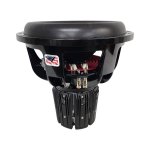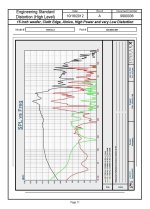Just one question, what would be the advantages of an underhungs vs overhungs woofer, which reproduces a wide range of frequencies (50 to 2,000 hz)?
From what I know, underhung woofers would have better magnetic flux than overhung woofers, thus reducing distortions, but depending on the cost they may have lower xmax (excursion), in addition to the fact that when the excursion limit is exceeded the distortion level is greater than the overhungs.
An example of a subwoofer with high xmax (excursion).
From what I know, underhung woofers would have better magnetic flux than overhung woofers, thus reducing distortions, but depending on the cost they may have lower xmax (excursion), in addition to the fact that when the excursion limit is exceeded the distortion level is greater than the overhungs.
An example of a subwoofer with high xmax (excursion).
Attachments
Last edited:
Underhung vs overhung is a similar argument as sealed vs ported. They’re both very different and one technology is better than the other in different applications. A quick Google search will provide many pros/cons for you.
For woofers there is no advantage being under hung construction.
But up to xo 2khz the underhung can have a lighter voice coil.
This reduces the area of the voice coil for heat transfer.
Fullrange drivers profit even more from this design
But up to xo 2khz the underhung can have a lighter voice coil.
This reduces the area of the voice coil for heat transfer.
Fullrange drivers profit even more from this design
I read about them on Wikipedia and other sites.Underhung vs overhung is a similar argument as sealed vs ported. They’re both very different and one technology is better than the other in different applications. A quick Google search will provide many pros/cons for you.
I understand that they are different technologies with different advantages and disadvantages.
Underhung vs overhung:
Likely lower voice coil inductance, better for midrange use;
Better cooling;
Possibly better coil inductance variation due to coil movement in the gap (Klippel tests will tell), thus better midrange;
Lighter voice coil assembly.
Overhung vs underhung:
Cheaper;
Lighter magnet (in pro audio that counts) structure.
Likely lower voice coil inductance, better for midrange use;
Better cooling;
Possibly better coil inductance variation due to coil movement in the gap (Klippel tests will tell), thus better midrange;
Lighter voice coil assembly.
Overhung vs underhung:
Cheaper;
Lighter magnet (in pro audio that counts) structure.
It was gone, but I'm back here.
A new question, Would an underhung woofer play better in a sealed box with lots of damping material (50% or more of the box) than an overhung woofer?
I once saw a video from SVS saying that underhung is more "optimized" for ventilated boxes, but I think it depends more on other parameters besides Bl.
A new question, Would an underhung woofer play better in a sealed box with lots of damping material (50% or more of the box) than an overhung woofer?
I once saw a video from SVS saying that underhung is more "optimized" for ventilated boxes, but I think it depends more on other parameters besides Bl.
What is "better" depends on what parameters you put the most priority to in which end of the frequency spectrum, and the volume of the sealed box compared to the Vas and Bl of the driver.A new question, Would an underhung woofer play better in a sealed box with lots of damping material (50% or more of the box) than an overhung woofer?
I once saw a video from SVS saying that underhung is more "optimized" for ventilated boxes, but I think it depends more on other parameters besides Bl.
Good example of using nearly the same materials and optimizing them for a larger vented box or a smaller sealed box covering a limited frequency range.
(Sub)woofers covering the decade from 15Hz to ~150Hz will have much different design parameters than a wide band woofer required to perform well in the decade from 50-500Hz plus two more octaves to 2kHz.
Not to say that a 50-2kHz driver with ~40mm Xmax is impossible, but practically with current materials, one that performs well at 2kHz is limited to ~6-10mm Xmax.
TangBand make a number of underhung designs if you are interested in looking at some examples.
https://www.tb-speaker.com/products/w5-1880
https://www.tb-speaker.com/products/w6-1721
Very generally speaking underhung designs have lower distortion but also reduced max than overhung. But there are so many other factors it's not a rule you can trust.
https://www.tb-speaker.com/products/w5-1880
https://www.tb-speaker.com/products/w6-1721
Very generally speaking underhung designs have lower distortion but also reduced max than overhung. But there are so many other factors it's not a rule you can trust.
Assuming you mean xmax, and why is that?
It is just about cost efficiency, you can make a underhung woofer with the same excursion
potential, it is just a lot more expensive to build🙃
As it will need a really deep gap(meaning loads of magnets), and a very strong magnetic circuit to keep flux high.
Look at my link above for an example.
There exists sub drivers with 30mm excursion capability in underhung configurations, just a example
Last edited:
JBL once claimed lower distortion for theyr underhung woofer, it had a ~9kg magnetic assembly with alnico magnet, 4" voicecoil only 4.6mm high if i remember correctly
Last edited:
Have a look yourself.JBL once claimed lower distortion for theyr underhung woofer, it had a ~9kg magnetic assembly with alnico magnet, 4" voicecoil only 4.6mm high if i remember correctly
Just notice the distortion is raised by +20db 🙂
Attachments
Actually this is really what is missing on the market.Underhung vs overhung:
Likely lower voice coil inductance, better for midrange use;
Better cooling;
Possibly better coil inductance variation due to coil movement in the gap (Klippel tests will tell), thus better midrange;
Lighter voice coil assembly.
Just some very nice and well optimized underhung mid-range woofers, capable of performing >80Hz.
Not just for silly and stupid amounts of cone excursion, or for subwoofer range.
Something most companies seem to just focus on unfortunately.
The vast majority try to compromise both, leaving us with worst of both worlds.
Look at the measurements of the Aurasound NS18 on data-bass. At this point probably out of production for two decades, but still elite.What is "better" depends on what parameters you put the most priority to in which end of the frequency spectrum, and the volume of the sealed box compared to the Vas and Bl of the driver.
View attachment 1273833
Good example of using nearly the same materials and optimizing them for a larger vented box or a smaller sealed box covering a limited frequency range.
(Sub)woofers covering the decade from 15Hz to ~150Hz will have much different design parameters than a wide band woofer required to perform well in the decade from 50-500Hz plus two more octaves to 2kHz.
Not to say that a 50-2kHz driver with ~40mm Xmax is impossible, but practically with current materials, one that performs well at 2kHz is limited to ~6-10mm Xmax.
Aurasound made really cool underhung designs, the 1808 preceded the NS18.

The 1808 50mm gap depth, 24.4mm coil length, 19mm Xmax was really something back around 1997 when I received the cut sheet.
I didn't click to the fact it had more than double the displacement of the drivers I was using back then for another decade or so..
Art
The 1808 50mm gap depth, 24.4mm coil length, 19mm Xmax was really something back around 1997 when I received the cut sheet.
I didn't click to the fact it had more than double the displacement of the drivers I was using back then for another decade or so..
Art
Last edited:
Aurasound made really cool underhung designs, the 1808 preceded the NS18.
Attachments
- Home
- Loudspeakers
- Multi-Way
- underhung woofers


